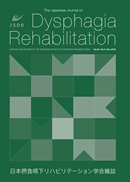Volume 17, Issue 1
The Japanese Journal of Dysphagia Rehabilitation
Displaying 1-9 of 9 articles from this issue
- |<
- <
- 1
- >
- >|
Original Paper
-
2013 Volume 17 Issue 1 Pages 3-12
Published: April 30, 2013
Released on J-STAGE: April 30, 2020
Download PDF (400K) -
2013 Volume 17 Issue 1 Pages 13-24
Published: April 30, 2013
Released on J-STAGE: April 30, 2020
Download PDF (648K) -
2013 Volume 17 Issue 1 Pages 25-35
Published: April 30, 2013
Released on J-STAGE: April 30, 2020
Download PDF (757K) -
2013 Volume 17 Issue 1 Pages 36-44
Published: April 30, 2013
Released on J-STAGE: April 30, 2020
Download PDF (832K) -
2013 Volume 17 Issue 1 Pages 45-51
Published: April 30, 2013
Released on J-STAGE: April 30, 2020
Download PDF (414K) -
2013 Volume 17 Issue 1 Pages 52-59
Published: April 30, 2013
Released on J-STAGE: April 30, 2020
Download PDF (323K)
Short Communication
-
2013 Volume 17 Issue 1 Pages 60-67
Published: April 30, 2013
Released on J-STAGE: April 30, 2020
Download PDF (389K)
Case Report
-
2013 Volume 17 Issue 1 Pages 68-75
Published: April 30, 2013
Released on J-STAGE: April 30, 2020
Download PDF (497K) -
2013 Volume 17 Issue 1 Pages 76-83
Published: April 30, 2013
Released on J-STAGE: April 30, 2020
Download PDF (1037K)
- |<
- <
- 1
- >
- >|
